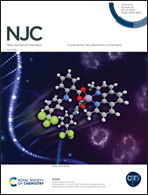Substituted (P, As, Sb, S and Se) two-dimensional Bi2Te3 monolayer under stress at high temperature: achieving high thermoelectric performance
Abstract
To study the characteristics and laws of the extensive application of superior thermoelectric properties near room temperature in thermoelectric devices, element substitution in two-dimensional (2D) Bi2Te3-based materials was studied using density functional theory and semi-classical Boltzmann theory. It worth noting that substituting the VA family (P, As, and Sb) in Bi2Te3, resulting in BiPTe3, BiSbTe3, and BiAsTe3 alloys, resulted in lower lattice thermal conductivity (k = 0.36 W m−1 K−1, 0.30 W m−1 K−1, and 0.34 W m−1 K−1), which enhanced the merit figure of ZT value from 0.61 for the pure Bi2Te3 system to 1.01, 1.08 and 1.10 at 300 K, respectively. Our results indicated that the group-VA (X = P, As, and Sb)-substituted Bi2Te3 BiPTe3, BiSbTe3 and BiAsTe3 alloys are promising candidates for thermoelectric applications near room temperature and compressive strain can effectively improve the ZT value of n-type structures. Especially, the compressive strain effect on the TE performance of n-type BiAsTe3 single-layer alloy can improve its n-type ZT value up to 1.904 at 800 K, which shows that its application can be extended to thermoelectric devices.



 Please wait while we load your content...
Please wait while we load your content...